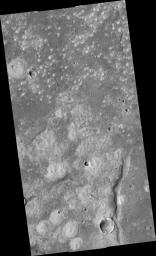
|
Knobs and Mounds on the Northern Plains
- Click the image above for a larger view
- Full-Res JPEG (2048 x 3361) (1.1 MB)
- Full-Res TIFF (2048 x 3361) (6.9 MB)
Caption:
This image shows surface features on the northern plains of Mars.
Light-toned mounds occur across the image. The northern part of the image is dominated by small knobs or patches, while there are features hundreds of meters across to the south. The larger features frequently have one or more craters and an irregular shape; it has been proposed that these features are mud volcanoes, which erupt mud instead of lava. On Earth, mud volcanoes usually form in conditions of tectonic pressurization or rapid burial of sediments.
At high resolution, the knobs show some fine lineations which may be wind-blown material, but are otherwise very smooth. In between the mounds the surface is rough and rich in boulders. The few boulders on the mounds were likely ejected from nearby impact craters. Information like this from HiRISE images provides useful constraints on the formation and material of these knobs and cones.
Observation Geometry
Image
PSP_001916_2220
was taken by the High Resolution Imaging Science Experiment (HiRISE) camera onboard the Mars Reconnaissance Orbiter spacecraft on 23-Dec-2006. The complete image is centered at 41.8 degrees latitude, 332.5 degrees East longitude. The range to the target site was 302.4 km (189.0 miles). At this distance the image scale ranges from 30.3 cm/pixel (with 1 x 1 binning) to 60.5 cm/pixel (with 2 x 2 binning). The image shown here has been map-projected to 25 cm/pixel and north is up. The image was taken at a local Mars time of 03:24 PM and the scene is illuminated from the west with a solar incidence angle of 55 degrees, thus the sun was about 35 degrees above the horizon. At a solar longitude of 155.1 degrees, the season on Mars is Northern Summer.
Background Info:
NASA's Jet Propulsion Laboratory, a division of the California Institute of Technology in Pasadena, manages the Mars Reconnaissance Orbiter for NASA's Science Mission Directorate, Washington. Lockheed Martin Space Systems, Denver, is the prime contractor for the project and built the spacecraft. The High Resolution Imaging Science Experiment is operated by the University of Arizona, Tucson, and the instrument was built by Ball Aerospace and Technology Corp., Boulder, Colo.
Cataloging Keywords:
| Name | Value | Additional Values |
|---|---|---|
| Target | Mars | |
| System | ||
| Target Type | Planet | |
| Mission | Mars Reconnaissance Orbiter (MRO) | |
| Instrument Host | Mars Reconnaissance Orbiter | |
| Host Type | Orbiter | |
| Instrument | High Resolution Imaging Science Experiment (HiRISE) | |
| Detector | ||
| Extra Keywords | Crater, Grayscale, Impact, Map, Volcano | |
| Acquisition Date | ||
| Release Date | 2007-01-17 | |
| Date in Caption | ||
| Image Credit | NASA/JPL/Univ. of Arizona | |
| Source | photojournal.jpl.nasa.gov/catalog/PIA09565 | |
| Identifier | PIA09565 | |
